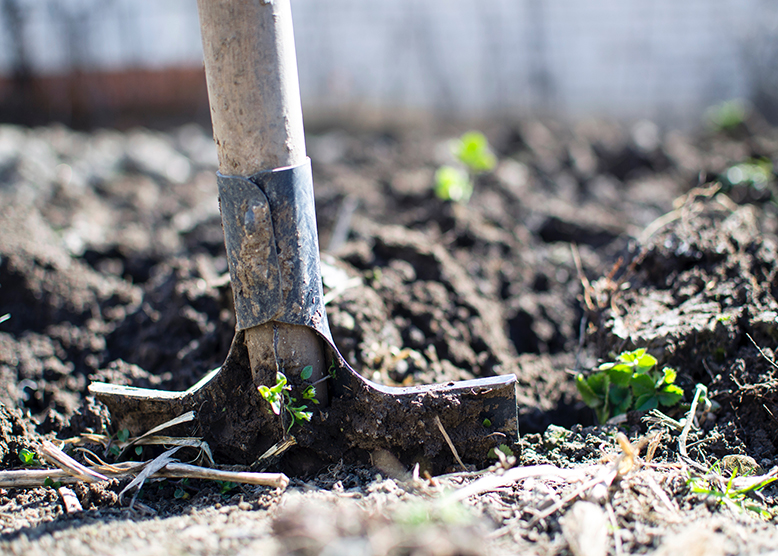
Get Ready for Gardening! Here Are Some Steps to Take Now
In many areas of the country, late-March and early-April weather may be too chilly for planting. The ground is still thawing, the chilly winds are still blowing, and, in some cases, there may be a late snowfall! Once the snows clear, this is a great time to start spring cleanup and get your garden ready for the growing season. A cleaned-up garden space will make your plants, shrubs, and trees healthier and prettier!
Spring Cleanup
You thought you got rid of all those pesky leaves last fall! The winter winds may have blown leaves and debris back into the garden. Decaying debris may harbor fungal spores and diseases. Spring cleanup will help rid your garden of potential problems. Use some care as you rake your garden, being careful as you clean up around newly emerging shoots from perennial plants and ferns.
To go even further in protecting your garden from pests and diseases this season, try using Eco-1 Garden Spray on plants when you begin growing. It’s non-toxic to people and pests, has a vegan formulation for all-purpose use, and can be used on crops the same day as they are harvested. Taking preventative measures such as this will help start your garden off fresh next year.
Pruning
Early spring is generally the best time to prune woody plants like trees and shrubs. It’s not unusual to find some winter damage. Look for diseased, damaged, and broken limbs. Sharpen your pruning shears or replace the blade before you begin pruning. Correct pruning technique is very important. If you do not know how to prune, consult a pruning guide. We recommend “Cass Turnbull’s Guide to Pruning.” Improper pruning cuts can, in some cases, damage or even kill a shrub or tree. If you are unsure of how to proceed, it may be best to engage the help of a professional.
Improving Your Soil
While spring cleanup in the garden is important, sometimes this process strips away the organic material which makes soil healthy. It is important to assess the health of your soil and add amendments. Have your soil tested every couple of years to get an idea of your soil fertility. A soil test will tell you the pH of your soil as well as the nutrient content and any deficiencies. Your soil test results may give suggestions for necessary soil amendments. A great place to get a soil test is through your state cooperative extension service.
Using the proper fertilizer to amend your soil can help with the health and longevity of plant life and reduce problems in the future. If you’re unsure where to start, try NutriRoot®, designed to stimulate root growth and reduce water stress in trees, shrubs, and lawns. It also helps root development, water stress management, and nutritional deficiencies. ARBORChar® All Purpose Grow 5-6-4 is a fertilizer and biochar blend that not only offers your plants a balance of nutrients, but also helps build better soils. For more on which fertilizer formulations to use to boost your soil, see our blog post, “What’s the Dirt on Fertilizer”!
Mulching
Applying mulch is an important part of getting your garden ready for spring. Once you have completed your spring garden cleanup, consider spreading a couple of inches of mulch in your garden beds. Many feel that this gives the garden a “finished” look, but mulch does so much more – it helps retain moisture by reducing evaporation, helps water move through the soil, discourages weed growth, and protects shallow roots. As mulch decomposes, it adds nutrients to the soil.
Edging
If your garden beds border your lawn, making a clean edge does help give your yard a finished look. Making a clean edge helps keep mulch off the lawn and keeps the turf grass from growing into your garden beds. There are special tools for edging, but you can use the regular flat garden spade. Make a clean, straight cut, down a couple of inches, along the border between the turf and the garden bed. Next, gently mound up the soil in the garden bed away from the cut edge. Spend a little time make this edge look neat and weed-free.
Filling Gaps in the Garden Landscape
Unfortunately, sometimes plants, shrubs, or trees just do not make it through the winter. Examine your garden for gaps in the landscape created by winter-kill and remove any dead plants. It’s a good idea to keep notes on which plants thrived or failed in your garden. Although it might be disheartening to remove a plant, this gives us the opportunity to reassess what works best in our garden. Your soil test will help you make good choices on plants that might do well in your garden.
Bulbs Finished Blooming
If you have spring bulbs planted in your garden beds, like most people, you may wonder what to do after the blooms have faded. Do you cut back the yellowing foliage or leave it to continue dying back? Although it doesn’t look great, it’s best to let bulb foliage to die back. This allows the underground bulb to grow and store nutrients, which produces more flowers next spring!
Most importantly, now is the time to start setting goals for your garden this growing season. Make note of what you’d like to see and the steps it will take to get there, and you’ll have a great guide to lean on in the coming months! What steps are you taking to get ready for gardening this spring? Share with us on Facebook, Twitter, and Instagram!


Sorry, the comment form is closed at this time.